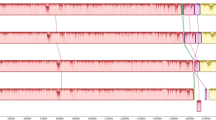Abstract
Many herpesviruses, poxviruses and retroviruses encode proteins related to chemokines and chemokine receptors. The first one discovered, US28 of human cytomegalovirus (HCMV), is a 7-transmembrane domain G protein-coupled chemokine receptor able to activate diverse cellular responses, including cell migration and gene expression. A related ORF named US27 is adjacent to US28, but no functions have been defined yet. Recently ORFs 3–7, a cluster of five concatenated ORFs with highest homology to US28 and mammalian chemokine receptors, were sequenced from a prototype “stealth virus”, an African green monkey simian CMV (SCMV)-related entity with unusual fungal, bacterial and mammalian gene homologues. Stealth viruses have not yet been independently replicated in tissue culture, and therefore their biological significance remains unclear. ORF3, ORF4, ORF5 and ORF6 are complete ORFs whereas the sequence of ORF7 is incomplete. In the present study, we identified five corresponding ORFs in the genome of a clinical isolate of bonafide simian CMV (SCMV), strain 9610. We found substantial differences between the SCMV and “stealth virus” ORFs, especially for ORF5 where there are 31% non-identities at the amino acid level. Four conserved genes unrelated to chemokines (64K/CAP, DNBI, UL32, and IE2) in SCMV and HCMV had on average 52% identity at the deduced amino acid level, whereas the corresponding values for the SCMV ORFs versus US28 ranged from 21% to 30%, suggesting rapid gene diversification in this cluster. Consistent with this, the amino acid identity for any pairwise comparison among the SCMV ORFs is only 21–52%. The chemokine receptor homologues are estimated to comprise ∼2–3% of the SCMV genome. HCMV US27 and US28 homologues have also been identified in the chimpanzee CMV genome, whereas mouse and rat CMV lack chemokine receptor homologues. This genomic analysis indicates that SCMV has an unusually high concentration of US28-related chemokine receptor homologues that have arisen by gene duplication and have diverged extensively from their closest relatives in mammals and other β herpesviruses. The rate of divergence appears to be very rapid compared to other known SCMV genes, suggesting strong positive selection.
Similar content being viewed by others
References
Murphy P.M., Pharmacol Rev 54, 227–229, 2002.
McFadden G., and Murphy P.M., Curr Opin Microbiol 3, 371–378, 2000.
Pease J.E., and Murphy P.M., Semin Immunol 10, 169–178, 1998.
Murphy P.M., Nat Immunol 2, 116–122, 2001.
Ahuja S.K., Gao J.L., and Murphy P.M., Immunol Today 15, 281–287, 1994.
Parcells M.S., Lin S.F., Dienglewicz R.L., Majerciak V., Robinson D.R., Chen H.C., Wu Z., Dubyak G.R., Brunovskis P., Hunt H.D., Lee L.F., and Kung H.J., J Virol 75, 5159–5173, 2001.
Gao J.L., and Murphy P.M., J Biol Chem 269, 28539–28542, 1994.
Beisser P.S., Grauls G., Bruggeman C.A., and Vink C., J Virol 73, 7218–7230, 1999.
Beisser P.S., Vink C., Van Dam J.G., Grauls G., Vanherle S.J., and Bruggeman C.A., J Virol 72, 2352–2363,1998.
Arvanitakis L., Geras-Raaka E., Varma A., Gershengorn M.C., and Cesarman E., Nature 385, 347–350, 1997.
Schwarz M., and Murphy P.M., J Immunol 167, 505–513, 2001.
Cesarman E., Mesri E.A., and Gershengorn M.C., J Exp Med 191, 417–422, 2000.
Guo H.G., Browning P., Nicholas J., Hayward G.S., Tschachler E., Jiang Y.W., Sadowska M., Raffeld M., Colombini S., Gallo R.C., and Reitz M.S. Jr., Virology 228, 371–378, 1997.
Yang T.Y., Chen S.C., Leach M.W., Manfra D., Homey B., Wiekowski M., Sullivan L., Jenh C.H., Narula S.K., Chensue S.W., and Lira S.A., J Exp Med 191, 445–454, 2000.
Guo H.G., Sadowska M., Reid W., Tschachler E., Hayward G., and Reitz M., J Virol 77, 2631–2639, 2003.
Ahuja S.K., and Murphy P.M., J Biol Chem 268, 20691–20694, 1993.
Wakeling M.N., Roy D.J., Nash A.A., and Stewart J.P., J Gen Virol 82, 1187–1197, 2001.
Murphy P.M., J Clin Invest 105, 1515–1517, 2000.
Vink C., Beisser P.S., and Bruggeman C.A., Intervirology 42, 342–349, 1999.
Vink C., Beuken E., and Bruggeman C.A., J Virol 74, 7656–7665, 2000.
Pleskoff O., Treboute C., Brelot A., Heveker N., Seman M., and Alizon M., Science 276, 1874–1878, 1997.
Pleskoff O., Treboute C., and Alizon M., J Virol 72, 6389–6397, 1998.
Streblow D.N., Soderberg-Naucler C., Vieira J., Smith P., Wakabayashi E., Ruchti F., Mattison K., Altschuler Y., and Nelson J.A., Cell 99, 511–520, 1999.
Martin W.J., Exp Mol Pathol 69, 10–16, 2000.
Camarda G., Spinetti G., Bernardini G., Mair C., Davis-Poynter N., Capogrossi M.C., and Napolitano M., J Virol 73, 9843–9848, 1999.
Davis-Poynter N.J., Lynch D.M., Vally H., Shellam G.R., Rawlinson W.D., Barrell E.G., and Farrell H.E., J Virol 71, 1521–1529, 1997.
Murphy P.M., Cell 72, 823–826, 1993.
Author information
Authors and Affiliations
Corresponding author
Rights and permissions
About this article
Cite this article
Sahagun-Ruiz, A., Sierra-Honigmann, A.M., Krause, P. et al. Simian Cytomegalovirus Encodes Five Rapidly Evolving Chemokine Receptor Homologues. Virus Genes 28, 71–83 (2004). https://doi.org/10.1023/B:VIRU.0000012265.33168.b5
Issue Date:
DOI: https://doi.org/10.1023/B:VIRU.0000012265.33168.b5




